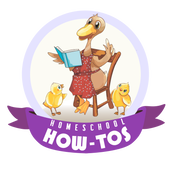You've heard of the halls of education? Well, here now, we'll be constructing the wall of education :) : a wall dedicated only to home schooling materials. Nothing else is allowed to even be set there.
Assemble it simply with long boards and cinderblocks. Create a headspace of about 12 inches between shelves and build it only about 3 to 3.5 feet high. This whole structure is totally portable; you can move it whenever you have to.
Now this is what you put in, on and above it:
In it:
Set each of your Sterlite™ box totes into a cubby hole assigned to each child with his name labeled on that shelf. He is always to return his box exactly there. Nothing else is to be kept in these cubby holes or totes—only immediate academic materials and their current reading book and Bible. Underneath each tote, slid directly under the tote spine-side facing out. (This tilts their totes slightly upward and inward—an added plus. In these notebooks will go all artwork and writings. No free floating papers in their totes!
On it:
- The clean long surface on the top of the bookcase which ends up being about waist height—will now be filled in with this stuff:
- A box of the extra course books/booklets, the ones your children aren't working on currently —all labeled according to subject and grade levels with taller stiffer paper between each section.
- A three-hole punch
- A box of scratch paper
- Spare pencils, colored pencils, scissors, tape and markers.
- And multiple approved recreational reading books, with bookends (covered bricks hold them nicely).
Above it:
- A large flat paper map of the world
- A large clock
- A large wall non-gloss calendar that can be easily written on
- A schooling chart (made of 1/2 inch graph paper) with all of the children's names down the left side and all the topics across the top—a red marker tied to a long string and nailed next to it to mark off their work as they do it each day. This frees mom up from keeping track of it all. All she has to do is look at the large chart and presto she knows what each child has done and not done.
- the Homeschool How-Tos Zoom-Type course
- the little yellow art book (email me about that)
[Optional—but a really good idea—a visible progress board (just a section of that wall…no actual board) dedicated to Mom and/or Dad's progress on their big projects. You put up Post-it notes directly on the wall of what is left to do—one item per Post-it note—written in large print with a marker—(no pen or pencil—can't see such writing a foot away)—when you get an idea, or remember another next step that you’d forgotten, you write it down and post it up there—all future steps are written out up there—then as each step is accomplished it is taken off the wall and put at the bottom of the wall—so that you can see the stack grow at the bottom of all you accomplished. This is a simple, marvelous, easy tracking system.]
Nearby:
A piano keyboard set nearby that has headsets—sparing Mom and Dad and everyone else from hearing the younger set's first months of piano playing. A practice chart directly above it with each of the children's names on it, and what they are to practice next.
Voilá—more academic organization than you ever dreamed—now in place—you've got your "horse to ride" sitting right in the stall—and YOU DID IT!








